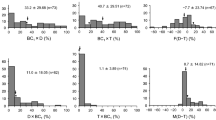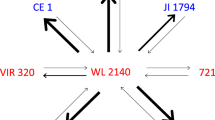Summary
Yield components including total tuber yield, total tuber number, vine maturity, vine vigor and average tuber weight as well as seed germination and pollen stainability were studied in 28 exact reciprocal hybrid families, between 12 Solanum tuberosum Group Tuberosum (haploid) (TH) and 12 S. tuberosum Group Phureja (PH) clones in a NC Mating Design II in 4 sets of 3 by 3 reciprocal hybrids at three locations, one in Minnesota (USA) and two in Morocco. TH parents were insensitive to daylength whereas most PH clones required critical photoperiods equal to or less than 14 hours for tuberization. Mean reciprocal differences were significant for most traits at all 3 locations. Hybrids with TH cytoplasm were superior to those with PH cytoplasm by 18% for tuber yield, 21% for tuber number, and 9% for vine maturity, but inferior to hybrids with PH cytoplasm by 11% for vine vigor and 19% for time to reach 80% seed germination. Reciprocal differences were not detected for average tuber weight. Six reciprocal crosses revealed significant differences for pollen stainability but the overall mean difference (one location) was not significant. Possible reasons for the observed reciprocal differences included gamete selection, pseudo-self-compatibility and/or interaction of cytoplasm with both nuclear genes and environment. Differences for critical photoperiod of TH and PH parents were also demonstrated as a probable source of reciprocal differences.
Similar content being viewed by others
References
Ascher, P. D., 1976. Self-incompatiblity systems in floriculture crops. Acta Horticulturae 63: 205–215.
Brewbaker, J. L., 1954. Incompatibility in autotetraploid Trifolium repens L. I. Competition and self-compatibility. Genetics 39: 307–316.
Cipar, M. S., S. J. Peloquin & R. W. Hougas, 1964. Inheritance of incompatibility in hybrids between Solanum tuberosum haploids and diploid species. Euphytica 13: 163–172.
Comstock, R. E. & H. F. Robinson, 1952. Estimation of average dominance of genes. In: J. W. Gowen (Ed.), Heterosis. p. 494–516. Iowa State College Press, Ames. Iowa.
Cubillos, A. G. & R. L. Plaisted, 1976. Heterosis for yield in hybrids between S. tuberosum spp. Tuberosum and S. tuberosum spp. Andigena. Amer. Potato J. 53: 143–150.
Ewing, E. E., 1978. Critical photoperiods for tuberization: A screening technique with potato cuttings. Amer. Potato J. 55: 43–53.
Fineman, Z. M., 1947. Elimination and retention of pollen sterility in potato improvement. J. Agric. Res. 75: 135–145.
Grun, P., 1970. Cytoplasmic sterilities that separate the cultivated potato from its putative diploid ancestors. Evolution 24: 750–758.
Haynes, F. L., 1972. The use of cultivated diploid Solanum species in potato breeding. In: E. R. French (Ed.). Prospects for the potato in the developing world: an international symposium on key problems and potentials for greater use of the potato in the developing world. July 17–29, 1972. International Potato Center, Lima, Peru.
Hermsen, J. G. Th., 1978. Genetics of self-compatibility in dihaploids of Solanum tuberosum L. 3. Lethality of S-bearing translocation homozygotes. Euphytica 27: 13–17.
Hoopes, R. W., 1978. Yield and fertility of reciprocal cross hybrids of Tuberosum and Andigena potatoes. PhD. Thesis. Cornell University. 138 pp.
Koopmans, A., 1959. Changes in sex in the flowers of the hybrid Solanum rybinii × S. chacoense. IV. Further data upon the reciprocal cross S. chacoense × S. rybinii. Genetica 30: 384–390.
McHale, N. A. & F. I. Lauer, 1981. Breeding value of 2n pollen from diploid hybrids and Phureja in 4x–2x crosses in potatoes. Amer. Potato J. 58: 365–374.
Mok, D. W. S. & S. J. Peloquin, 1975. Three mechanisms of 2n pollen formation in diploid potatoes. Can. J. Genet. Cytol. 17: 217–225.
Onsder, J. & J. G. Th. Hermsen, 1976. Genetics of self-incompatibility in dihaploids of Solanum tuberosum L. I. Breeding behavior of two self-compatible dihaploids. Euphytica 25: 597–607.
Ramanna, M. S. & J. G. Th. Hermsen, 1974. Unilateral ‘eclipse of sterility’ in reciprocal crosses between Solanum verrucosum S. and diploid S. tuberosum L. Euphytica 23: 417–421.
Robacker, C. D. & P. D. Ascher, 1981. Discriminating styles (DS) and pollen-mediated pseudo-self-compatibility (PMPSC) in Nemesia strumosa Benth. Theor. Appl. Genet. 60: 297–302.
Ross, R. W., S. J. Peloquin & R. W. Hougas, 1964. Fertility of hybrids from Solanum phureja and haploid S. tuberosum matings. Eur. Potato J. 7: 81–89.
Salaman, R. N. & J. W. Lesley, 1922. Genetic studies in potatoes: sterility. J. Agric. Sci. 12: 31–39.
Sanford, J. C. & R. E. HannemanJr., 1979. Reciprocal differences in the photoperiod reaction of hybrid populations in Solanum tuberosum. Amer. Potato J. 56: 531–540.
Sanford, J. C. & R. E. HannemanJr., 1982. Large yield differences between reciprocal families of Solanum tuberosum. Euphytica 31: 1–12.
Simmonds, N. W., 1964. Studies of the tetraploid potatoes. II. Factors in the evolution of the Tuberosum Group. J. Linn. Soc. (Bot.) 59: 43–56.
Tarn, T. R. & G. C. C. Tai, 1977. Heterosis and variation of yield components in F1 hybrids between Group Tuberosum and Group Andigena potatoes. Crop. Sci. 17: 517–521.
Veilleux, R. E. & F. I. Lauer, 1981. Breeding behavior of yield components and hollow heart in tetraploiddiploid vs. conventionally derived potato hybrids. Euphytica 30: 547–561.
Author information
Authors and Affiliations
Additional information
Scientific Journal Series Article 14896 of the Minnesota Agricultural Experiment Station supported in part by the U.S. Agency for International Development, contract no. 608-0160, IAV Morocco Project.
Rights and permissions
About this article
Cite this article
Hilali, A., Lauer, F.I. & Veilleux, R.E. Reciprocal differences between hybrids of Solanum tuberosum Groups Tuberosum (haploid) and Phureja. Euphytica 36, 631–639 (1987). https://doi.org/10.1007/BF00041513
Received:
Issue Date:
DOI: https://doi.org/10.1007/BF00041513




